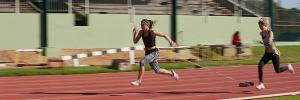
Research makes Games safer for Paralympic athletes
Stellenbosch University (SU) is leading a group of international researchers that will be studying the injuries and illnesses sustained at the Paralympic Games in order to make future events safer for athletes.
The Institute of Sports and Exercise Medicine (ISEM) at Maties has signed a memorandum of understanding with the International Paralympic Committee (IPC) to gather and analyse data on injuries and illnesses sustained at the Paralympic Games in Rio, as well as the subsequent Winter Paralympic Games in Pyeongchang (Korea) in 2018, and the 2020 Paralympic Games in Tokyo (Japan).
"By studying a large group of athletes like this – more than 3500 athletes are expected to compete at the Rio Paralympic Games – we are able to discern risk factors for illness and injury, which allows us to put preventative measures in place," says Prof Wayne Derman, director of ISEM at SU's Faculty of Medicine and Health Sciences (FMHS).
The study will be done in collaboration with Harvard University (United States), the University of Brighton (United Kingdom) and the University of Pretoria (South Africa).
The research will not focus only on sports-related injuries, but will record all injuries and illnesses sustained during the Games that could impact on sports performance. "An injury or illness doesn't have to be related to sport to impact on an athlete's performance. For example, a dental abscess or even influenza can take you from 'hero to zero' in a short space of time and ruin years of preparation," says Derman, who was involved in similar studies during the Sochi Winter Paralympics in 2014, and the London Paralympic Games in 2012.
Data for the study is collected through a web-based system, custom designed at ISEM whereby all doctors that accompany athletes to the Games log details of all the injuries and illnesses. In addition to measuring the number of athletes affected (incidence), the system also tracks the duration and specifics of an affliction, and reports on injury and illness in the number of "athlete days". This information also gives insight into the rates and severity of the injuries/illnesses sustained over the period of the Paralympic Games.
Similar studies into the previous Games have delivered interesting results. According a study published in the British Journal of Sports Medicine (2013:47), athletes competing in football 5-a-side ("blind football"), powerlifting, and goalball, sustained the highest number of injuries of all sports at the 2012 London Paralympics.
"The most injuries sustained with football 5-a-side were associated with foul play, and the most commonly injured body region was the lower extremity," says Derman, who was involved in the research.
The most common illnesses during the 2012 London Paralympics affected the respiratory, skin and digestive systems.
Derman led the research into the incidence of injury and illness at the 2014 Sochi Winter Paralympic Games, which was recently published in a two-part series in the British Journal of Sports Medicine (2016).
"These studies showed that Paralympic athletes are at a higher risk of injury and illness than Olympic athletes, and also that the Winter Games are more dangerous than the Summer Games," says Derman. The incidence of injuries sustained at the Winter Games (26.5 injuries/1000 athlete days) is more than double the incidence at the Summer Games (12.7 injuries/1000 athlete days).
There was a significantly higher incidence of injuries (41.1 injuries/1000 athlete days) with alpine skiing/snowboarding during the 2014 Winter Games at Sochi. The researchers ascribed the high injury rate to warm weather conditions melting the snow.
"Our data inform sporting organisations, coaches and athletes of risk factors associated with Winter sports for athletes with impairment. The identification of these risk factors provides the basis for injury prevention programmes at the athlete as well as at the organisational level," says Derman.
Media enquiries
Mandi BarnardMarketing Coordinator+27 (0)21 938 9505[email protected]Marketing and Communications OfficeFaculty of Medicine and Health Sciences Stellenbosch University
Website: www.sun.ac.za/health Facebook: www.facebook.com/SUhealthsciTwitter: @SUhealthsci
